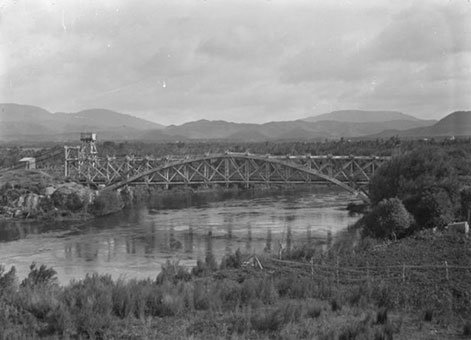At the time of its completion in 1905 the Ongaroto Bridge, across the Waikato River, was reputedly the longest single span timber bridge in the Southern Hemisphere. This bridge was demolished in the early 1930s.
Ongaroto Bridge was part of a railway link constructed by the Taupo Totara Timber Company (TTT) between its base at Putaruru and sawmill at Mokai, 23 km northwest of Taupo. The sawmill was built to extract Totara and Matai timber from the surrounding forests.

Substantial bridge over Waikato, 26 August 1905. National Newspaper Collection, Alexander Turnbull Library, Reference ID: C-26709-1/2-CT.
The TTT’s 80 km of one metre track, and associated river and stream crossings, were designed by James Edward Fulton (1854-1928). Fulton was a Wellington-based consultant civil engineer experienced in railway construction.
The Waikato River formed the major barrier for Fulton in designing the TTT’s railway. Initially, a two span girder bridge was considered to span the approximately 60 m at the crossing point. However, this idea was abandoned because of the river’s high flows and difficulty in founding a central pier. Instead a laminated timber through truss arch bridge was selected. Construction began with a temporary suspension bridge being erected at the site to provide limited access, as well as a platform from which to build the bridge.
The Ongaroto Bridge was built using green heart totara timber. The pairs of circular arches on each side of the bridge were created by seven 375 mm x 100 mm laminations bolted together at approximately 1 m centres. The arches enclosed a parallel chord girder truss, which provided load distribution. A feature of the design was that tension forces were transferred from member to member either by notches in the connected members, or timber “joggles” set into notches, or wrought iron plates set into notches. The locomotive and wagon loads were carried by rail beams which were mounted on transom beams. These transom beams were located in notches in the substantial vertical truss members, which in turn transferred the load to the arches through short bearers. The horizontal trusses, at top and bottom chord levels, provided lateral stiffness.
The bridge was completed in 1905 and served the needs of the TTT until 1931, when it was replaced with a two span steel girder rail bridge. This replacement structure was used until about 1950 when construction of Whakamaru Dam was taking place. Today there is a forestry road bridge over the lake at the old bridge’s site, 6 km downstream of the present day Atiamuri dam.

Longest single span wooden bridge in New Zealand..., February 1923. Alexander Turnbull Library, Wellington, New Zealand.
More information
Access
From Atiamuri Dam drive west along State Highway 30/Ongaroto Road, towards Whakamaru. Turn left at Tram Road. The former site of the bridge was over the Waikato River, near the intersection of Tram and Tirohanga Roads.
References
Fifty Years of Progress 1901-1951: Taupo Totara Timber Co. Ltd, Auckland, Taupo Totara Timber, 1951.
Kevin Cudby and Trevor Mitchell, 'Old Growth: Our timber engineering heritage - Ongaroto timber arch bridge,' New Zealand Timber Design Journal, Vol. 20:3 (2012), pp.3-7.
Additional image gallery details
Substantial bridge over Waikato, 26 August 1905. National Newspaper Collection, Alexander Turnbull Library, Reference ID: C-26709-1/2-CT.
This photograph of the bridge nearing completion was taken downstream on the southern bank. The suspended cables are from the previous bridge on the site which provided a base to construct the new bridge. The cables did not form an integral part of this structure.
Longest single span wooden bridge in New Zealand, carrying the Taupo Totara Timber Company line over the Waikato River at Ongaroto, February 1923. Godber, Albert Percy, 1875-1949: Collection of albums, prints and negatives. Ref: APG-1160-1/2-G. Alexander Turnbull Library, Wellington, New Zealand.
Permission of the Alexander Turnbull Library, Wellington, New Zealand, must be obtained before any re-use of these images.
Location
This bridge has been demolished. The site of the bridge was 6 kilometres downstream of existing Atiamuri Dam, Waikato.
